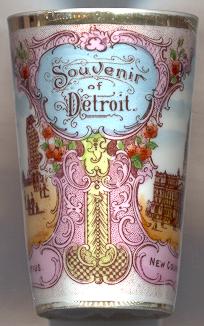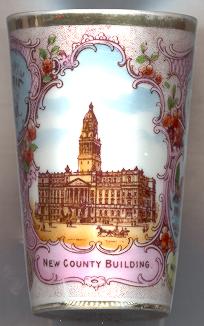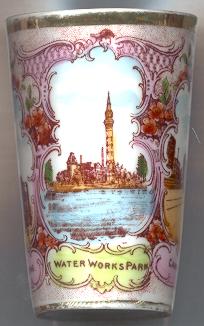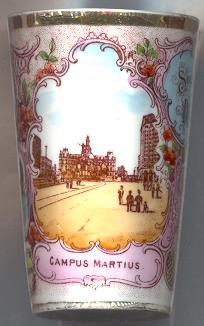

|
| UNITED STATES OF AMERICA | |
| MICHIGAN | |
| Wayne County |
 Detroit is located on Detriot River in Southeast Michigan north of Windsor, Ontario (Canada). Detroit was founded in 1701 by the French explorer
Antoine Loumet de la Mothe Cadillac. It was originally called Ville d’étroit (city on the strait). In 1718 the French built Fort Pontchartrain for
protection against the British. However, in 1760, it had to be surrendered to England. Being a Canadian city, the first civil government of Detroit was established under
the Quebec Act in 1774. After creation of the Judicial District of Hesse, Detroit and Michigan were part of upper Canada. Detroit was occupied by American troops in 1796
and Wayne County was established in honor of Major General Anthony Wayne (originally, the boundaries of Wayne County reached farther than Michigan itself).
Detroit became a town in 1802, but was completely destroyed by fire only three years later. However, in 1815 Detroit had been largely rebuilt and was incorporated as a city.
During the second half of the 19th century it became known for making railroad cars, locomotives, engines, stoves, carriages, paint and varnish, shoes and pharmaceuticals.
The year 1896 marked the beginning of the automobile era when Henry Ford built his first car (it sold for $950). During World War II Detroit took on a major role in the production of war materials, planes and tanks.
In 1963, the Rev. Martin Luther King jr. gave his first “I Have A Dream” speech, about two months before his famous delivery on August 28 in Washington, DC.
Detroit is located on Detriot River in Southeast Michigan north of Windsor, Ontario (Canada). Detroit was founded in 1701 by the French explorer
Antoine Loumet de la Mothe Cadillac. It was originally called Ville d’étroit (city on the strait). In 1718 the French built Fort Pontchartrain for
protection against the British. However, in 1760, it had to be surrendered to England. Being a Canadian city, the first civil government of Detroit was established under
the Quebec Act in 1774. After creation of the Judicial District of Hesse, Detroit and Michigan were part of upper Canada. Detroit was occupied by American troops in 1796
and Wayne County was established in honor of Major General Anthony Wayne (originally, the boundaries of Wayne County reached farther than Michigan itself).
Detroit became a town in 1802, but was completely destroyed by fire only three years later. However, in 1815 Detroit had been largely rebuilt and was incorporated as a city.
During the second half of the 19th century it became known for making railroad cars, locomotives, engines, stoves, carriages, paint and varnish, shoes and pharmaceuticals.
The year 1896 marked the beginning of the automobile era when Henry Ford built his first car (it sold for $950). During World War II Detroit took on a major role in the production of war materials, planes and tanks.
In 1963, the Rev. Martin Luther King jr. gave his first “I Have A Dream” speech, about two months before his famous delivery on August 28 in Washington, DC.

Just before the turn of the century, the Board of Supervisors of booming Wayne County decided the court system needed a new, larger home. Construction of
the  Wayne County Courthouse
Wayne County Courthouse

In 1879 the City of Detroit built what was to become one of the wonders of the world on 110 acres (45 hectares) of waterfront property – the City Water Works.
Better known as  Water Works Park
Water Works Park

 Campus Martius [right] at one time was the corner on which the city's life turned, the end of the line for the
Pontiac-Detroit railway and the city's electric streetcars. Campus Martius means „field of Mars“ or „military ground“. It served as a drill ground for the military
in 1788 and was named after the Campus Martius at Marietta, Ohio, the first capital of the Northwest Territory.
In the original 1806 city plan, the purpose of Campus Martius was spelled out as an open place
for large public assemblies, a city center. It was meant to be kept as a park in the middle of a
bustling downtown.
Campus Martius [right] at one time was the corner on which the city's life turned, the end of the line for the
Pontiac-Detroit railway and the city's electric streetcars. Campus Martius means „field of Mars“ or „military ground“. It served as a drill ground for the military
in 1788 and was named after the Campus Martius at Marietta, Ohio, the first capital of the Northwest Territory.
In the original 1806 city plan, the purpose of Campus Martius was spelled out as an open place
for large public assemblies, a city center. It was meant to be kept as a park in the middle of a
bustling downtown.
The  Old City Hall
Old City Hall
The  Soldiers and Sailors Monument
Soldiers and Sailors Monument
The  Majestic Building
Majestic Building
![[scale]](lineal.jpg)